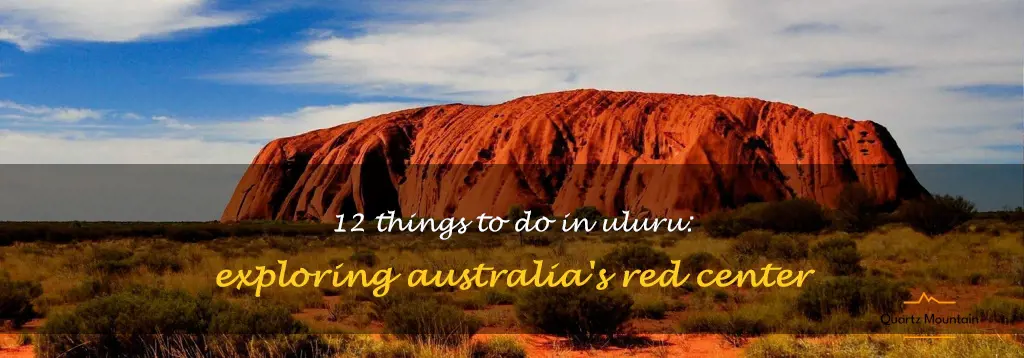
The majesty and mystique of Uluru, also known as Ayers Rock, is one of the world's most awe-inspiring natural wonders. Located in the heart of Australia's Red Center, this massive sandstone monolith is steeped in ancient indigenous culture and folklore. Whether it's witnessing the breathtaking sunrise and sunset over the rock, taking a scenic helicopter tour over the rugged desert terrain, or exploring the local wildlife and flora, there are plenty of incredible things to do in Uluru. So, get ready to pack your bags and embark on an unforgettable journey to this unique destination in the Land Down Under.
| Activity | Description |
|---|---|
| Sunrise and Sunset Viewing | The view of Uluru at sunrise and sunset is breathtaking, and it is a must-see attraction for any visitor! |
| Base Walk | A 10km walk that circles around the base of Uluru and offers different breathtaking perspectives of Uluru. |
| Stargazing | Uluru is located in the heart of the Australian Outback, making it one of the best places to stargaze and witness a brilliant array of stars. |
| Indigenous Cultural Experience | An opportunity to learn about and immerse yourself in the indigenous culture and history of the region. |
| Helicopter Tour | A thrilling way to explore Uluru and get a bird's eye view of the stunning landscape. |
| Camel Tour | A fun and unique way to experience Uluru while riding a friendly camel in the Australian Outback! |
| Sounds of Silence Dinner | A memorable five-star dining experience under the stars, showcasing a spectacular night view of Uluru while enjoying amazing food and music. |
| Segway Tour | A fun and easy way to explore the landscape of Uluru and learn about the geological formations of the region. |
What You'll Learn
- Watch the sunrise and sunset at Uluru
- Take a guided tour of Uluru and/or Kata Tjuta
- Walk the base of Uluru
- Visit the Cultural Center
- Experience traditional Aboriginal dance and music
- Camel ride in the Outback
- Visit the Field of Light at night
- Discover the Kings Canyon
- Learn about the Western Arrernte culture
- Hike in the Valley of the Winds
- Visit the Olgas
- Star gazing in the Outback

Watch the sunrise and sunset at Uluru
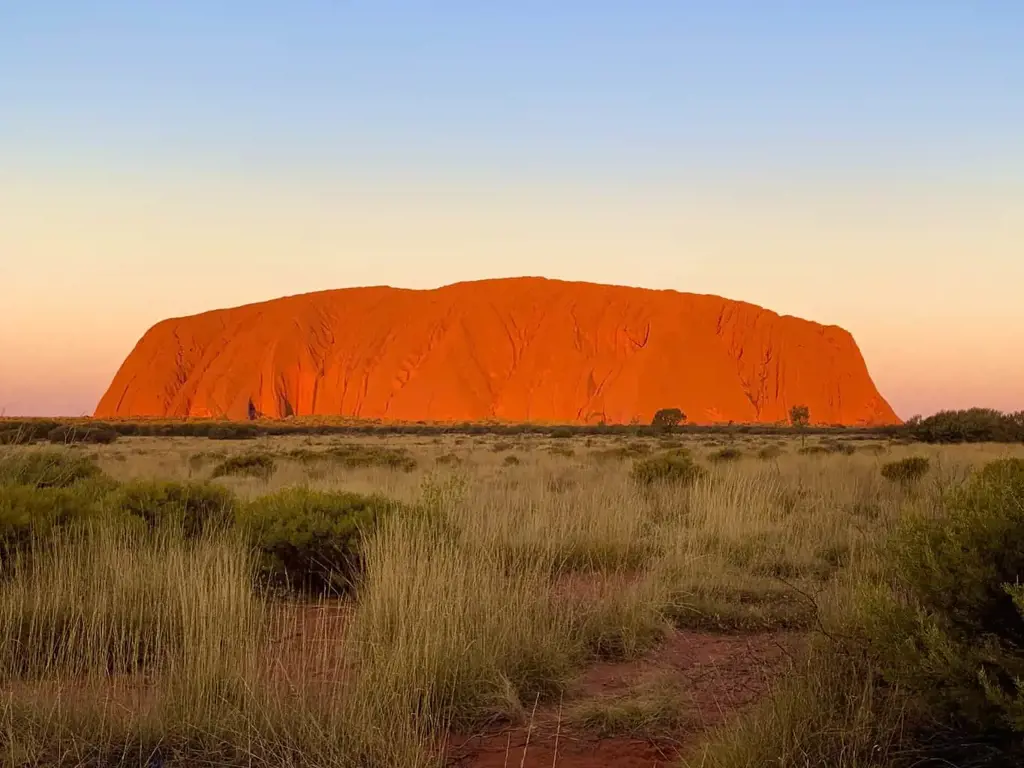
If you're planning a visit to Uluru, also known as Ayers Rock, there's no better way to experience the natural wonder than to watch the sunrise and sunset over the massive sandstone monolith.
Located in the heart of Australia's Red Centre, Uluru is a sacred site for the Anangu people, who have inhabited the region for tens of thousands of years. The formation, which rises more than 1,100 feet above the surrounding plain, is believed to have been created during the Dreamtime by ancestral beings.
Watching the sun rise and set over Uluru is an unforgettable experience. As the sun rises in the sky, the rock gradually changes color, from a deep purple to red, orange, and finally a glowing golden hue. In the evening, as the sun sets, the rock's colors reverse, gradually fading from bright orange to deep purple.
There are two popular viewing areas for watching the sunrise and sunset over Uluru. The first is at the Uluru-Kata Tjuta Cultural Centre, which is located about 15 minutes from the rock itself. Here, visitors can enjoy a light breakfast or afternoon tea while watching the rock change colors. The second, and more popular, option is to view the sunrise and sunset from the designated viewing areas at Uluru itself.
To catch the sunrise, visitors will need to be at the viewing area before dawn, which can mean getting up as early as 4:30am in the summer months. However, the early start is worth it for the breathtaking views.
As for watching the sunset, visitors can enjoy the views with a glass of champagne and a picnic in hand at one of the designated areas. However, it's important to note that visitors are asked to respect the Anangu people's wishes and not climb Uluru, as it is considered a sacred site.
Overall, watching the sunrise and sunset at Uluru is a must-do experience for anyone visiting the area. It's a peaceful and humbling way to appreciate the wonder of the natural world and to learn about the cultural significance of the rock to the Anangu people.
12 Must-Try Things to Do Near Quechee, VT
You may want to see also

Take a guided tour of Uluru and/or Kata Tjuta
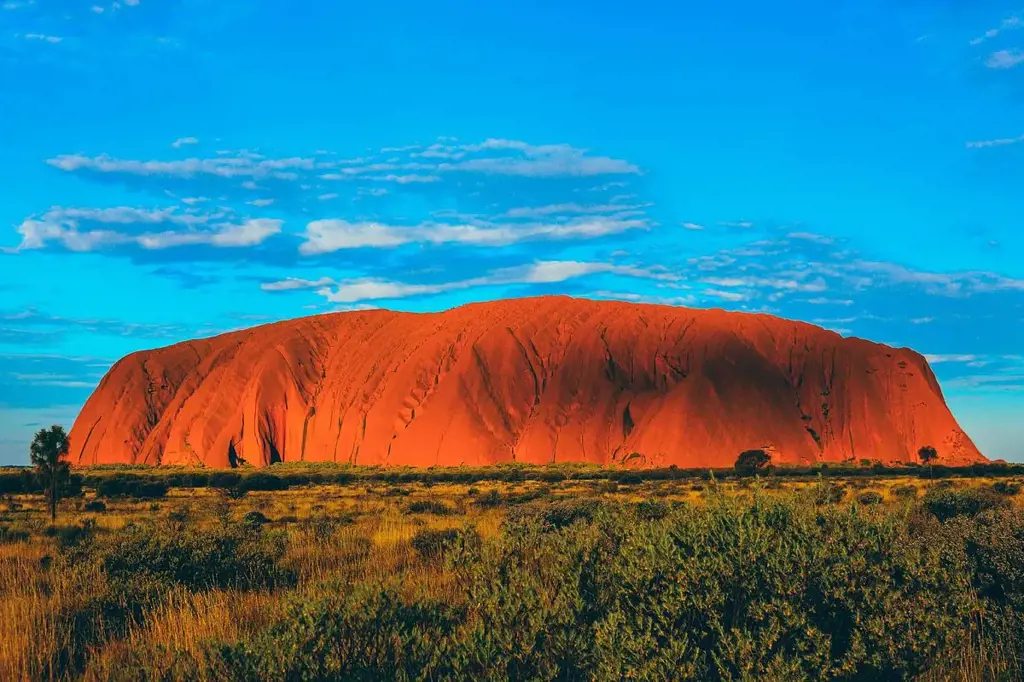
The sacred red rock formations of Uluru and Kata Tjuta are iconic landmarks that draw tourists from all over the world. Located in the heart of Australia's Red Centre, these natural wonders are sacred to the local Anangu people and have significant cultural and spiritual significance.
One of the best ways to experience the wonders of Uluru and Kata Tjuta is to take a guided tour with a local expert. A guided tour will help you gain a deeper understanding of the history and cultural significance of these sacred sites. You can explore the meaning behind the rock formations, and marvel at the unique flora and fauna that thrive in the harsh desert environment.
There are several guided tour options available to visitors, with tours ranging from short guided walks to more extensive tours that take in both Uluru and Kata Tjuta. Guided tours can be tailored to suit different interests, ages and fitness levels.
One popular guided tour option is the Sunrise Base Walk, which takes you on a six-kilometre walk around the base of Uluru. This tour starts before the sunrise, allowing you to experience the dramatic changes of sunlight illuminating the rock formation. You will also learn more about the various features of the rock formations and their significance to the local indigenous people.
For those who are looking for a more challenging experience, a guided tour to Kata Tjuta can be a great option. Nicknamed the "Valley of the Winds" due to the gusts that often blow through the gorges, Kata Tjuta is a stunning collection of 36 domes that are believed to date back to the beginning of time. Guided tours can take you deep into the gorges and valleys, where you can witness the unique flora and fauna that thrive in this unique desert environment.
Whether you choose to explore Uluru or Kata Tjuta, a guided tour is an excellent way to connect with the ancient landscape and indigenous culture of the region. You will come away with a deeper appreciation for the spiritual and cultural significance of these sacred landscapes and the traditions of the Anangu people who have lived in harmony with them for generations.
12 Fun Things to Do Near Devils Tower National Monument
You may want to see also

Walk the base of Uluru

Uluru, also known as Ayers Rock, is an iconic natural landmark located in Australia's Northern Territory. It is considered sacred to the Anangu people, the traditional owners of the area, and drawing in millions of visitors each year.
One of the best ways to experience Uluru is to take a walk around its base. The base walk is a 10.6-kilometer loop that takes about three to four hours to complete and offers stunning views of the monolith from different angles.
The walk starts at the Mala car park and follows the base of Uluru in a clockwise direction. Along the way, there are several viewing platforms and information boards that provide insights into the sacred sites and cultural significance of Uluru.
The first section of the walk passes through the Mala Walk, which takes visitors through a gorge and past rock art sites. The trail then takes visitors to the Mutitjulu Waterhole, a significant site for Anangu ceremonies and a place to rest and reflect.
Continuing the loop, the walk offers views of different geological formations of Uluru, such as crevices, gullies, and caves. The walk also takes visitors to the Kuniya Piti, a sacred site for the Anangu people, where the Kuniya and Liru Dreaming stories meet.
The final part of the walk passes through the Lungkata Walk, where visitors can see the unique flora and fauna of the area, including the spinifex grass and desert oak trees. The walk ends back at the Mala car park, where visitors can grab a refreshment or souvenir from the nearby café and gift shop.
Walking the base of Uluru is an immersive and educational experience that allows visitors to understand and appreciate the natural and cultural significances of this sacred site. It is important to respect the cultural protocols of the area, such as not climbing Uluru, staying on designated trails, and not taking photographs of sacred sites without permission.
In summary, if you are planning a visit to Uluru, make sure to take the time to walk around the base. It is a memorable and rewarding experience that offers a deeper understanding of this awe-inspiring natural wonder.
13 Fun Halloween Activities to Experience in Reno, Nevada
You may want to see also

Visit the Cultural Center

| Characteristic | Description |
|---|---|
| Name | Uluru-Kata Tjuta Cultural Centre |
| Type | Cultural center in Petermann, Australia |
| Website | Go to website |
| Rating / Review count | 4.4 / 2,077 |
| Address | Uluru Rd, Uluru NT 0872, Australia |
| Phone | +61 8 8956 1128 |
| Hours | Wednesday - 7 AM–6 PM Thursday - 7 AM–6 PM Friday - 7 AM–6 PM Saturday - 7 AM–6 PM Sunday - 7 AM–6 PM Monday - 7 AM–6 PM Tuesday - 7 AM–6 PM |
Visiting Uluru, also known as Ayers Rock, is an unforgettable experience that is highly recommended for anyone traveling through the Australian Outback. However, before taking in the extraordinary sight of the massive sandstone monolith, travelers should consider making a stop at the Cultural Center located at the entrance of Uluru-Kata Tjuta National Park.
The Cultural Center is designed to provide visitors with a deeper understanding of the Anangu people, who are the traditional custodians of the land. As well as being culturally enriching, it is a great way to prepare for your visit to the park and to gain a greater appreciation of the significance of Uluru and the surrounding landscape.
At the Cultural Center, visitors can learn about the history, stories and culture of the Anangu people. The exhibits include a variety of displays, videos, and interactive exhibits, each designed to provide greater understanding of the Indigenous way of life. For example, you can listen to traditional songs and learn about the Dreamtime legends of the area. Visitors can also witness demonstrations of traditional art forms, such as dot painting and woodcarving.
One of the most essential things to learn from the Cultural Center is the significance of the land, which is held sacred by the Anangu people. Visitors will learn how Uluru is not just a rock in the desert, but instead, it has an important spiritual meaning and significant Dreamtime stories connected to it. The Cultural Center also teaches visitors about the sensitivity to the environment, landscapes, and ecosystems, and how it is an integral part of the culture and way of life of the Ananugu people.
Moreover, the Cultural Center is a platform for reaching the visitors to educate to be a responsible tourists. The center provides information about the national park rules one should follow while taking your journey, such as avoiding off-water reservoir paths and littering, and respecting the culture and beliefs of the Anangu people.
Before you head out to take a look at the magnificent Uluru, make sure to drop by the Cultural Center to gain a deeper appreciation of the traditions, customs, and unique cultural heritage of the Anangu people. Take advantage of this opportunity to understand and appreciate Indigenous cultural heritage and protect it through sustainable tourism.
14 Fun-Filled Halloween Activities to Enjoy in Indianapolis
You may want to see also

Experience traditional Aboriginal dance and music
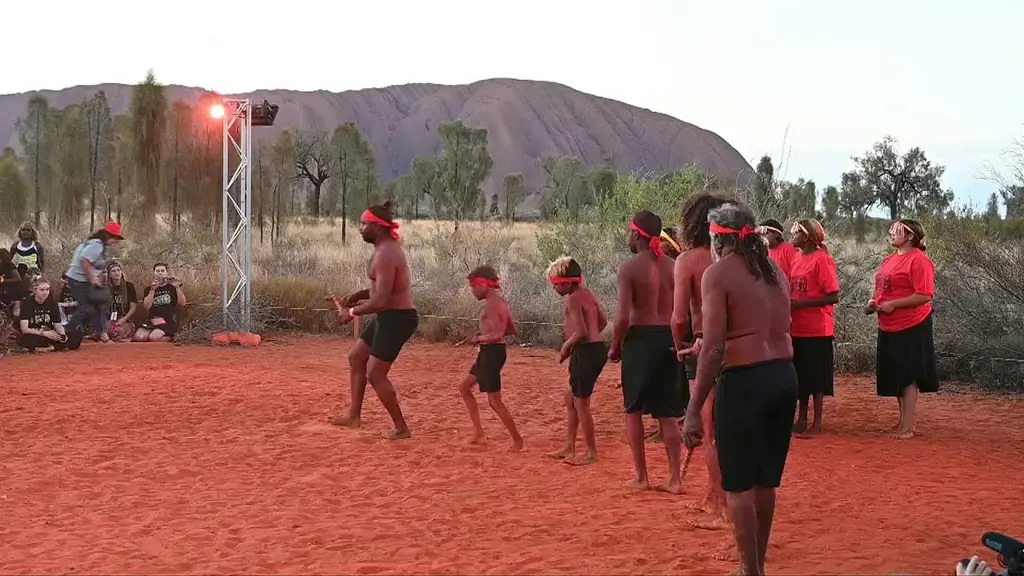
Uluru, also known as Ayers Rock, is a remarkable sandstone rock formation that is located in the heart of the Australian outback. This beautiful and awe-inspiring monolith has become a symbol of the rich culture and heritage of the indigenous Aboriginal people, who have lived in the area for tens of thousands of years. One of the best ways to experience the true essence of Uluru is by immersing yourself in traditional Aboriginal dance and music, which is an essential aspect of the local culture and way of life.
The traditional dances and music of the Aboriginal people are deeply rooted in their culture and spirituality, and they play an important role in their lives and their communities. These performances are a powerful way to connect with the land and the natural world, and they are often performed as part of ceremonies that mark significant events such as births, marriages, and deaths.
One of the most popular options for experiencing traditional Aboriginal dance and music at Uluru is attending the Sounds of Silence dinner. This unique experience offers visitors a chance to enjoy a candlelit dinner under the stars, while also taking in a performance of traditional Aboriginal dance and music. This is a fantastic opportunity to learn about the local culture and traditions while also savouring some delicious Australian cuisine.
Another great way to experience Aboriginal dance and music at Uluru is by attending one of the many cultural events and festivals that take place in the area. These events showcase the traditional dances, music, art, and customs of the Aboriginal people, and they are a great way to immerse yourself in their way of life and learn about their heritage. Some of the most popular events include the Tjungu Festival, which celebrates the culture of the Anangu people, and the Uluru Camel Cup, which features a range of traditional Aboriginal performances.
Finally, if you're interested in gaining a more in-depth understanding of Aboriginal culture and traditions, you can also take part in a cultural tour of the region. These tours are led by local Anangu guides, who will take you on a journey through the landscape and share their knowledge of the area's history, traditions, and beliefs. You will have the chance to witness traditional dance and music performances, as well as learn about the local flora and fauna, bush tucker, and other aspects of the local culture.
In conclusion, experiencing traditional Aboriginal dance and music is a must-do activity when visiting Uluru. It offers visitors a unique and authentic insight into the rich cultural heritage of the local Aboriginal communities, and it is a powerful way to connect with the natural world and the land on which we all live. By immersing yourself in these traditional performances, you will gain a deeper understanding and appreciation of the significance of Uluru and the culture that surrounds it.
12 Amazing Activities to Experience in Arlington Heights This Weekend
You may want to see also

Camel ride in the Outback
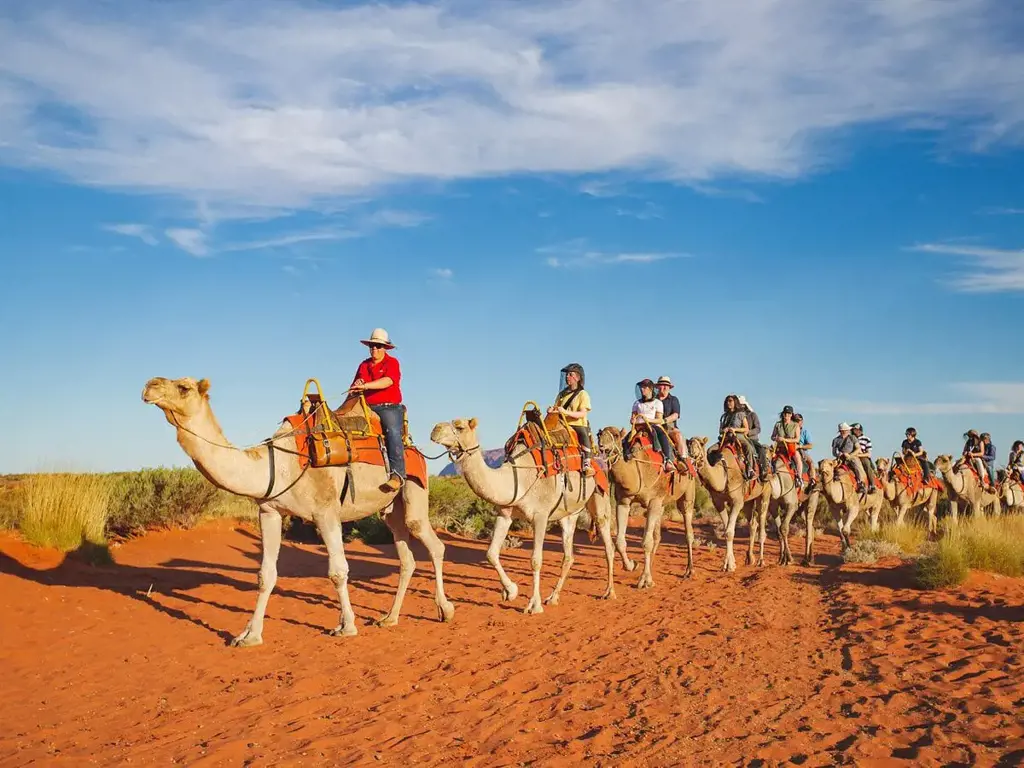
If you're visiting Uluru, one unique way to experience the iconic landmark is by going on a camel ride in the Outback. Camels were brought to Australia in the 19th century for transportation and are now used for tours and recreation.
Riding a camel is a different experience from riding a horse. Camels have an unusual gait, which can be bumpy at times, but also rhythmical at others. They are known for their gentle nature, and it is a great way to get up close and personal with these magnificent animals.
The tours usually last about an hour, with scenic routes and knowledgeable guides that will impart a lot of interesting information about the history and culture of the area. The tours typically start early in the morning or late in the afternoon, so you can avoid the hottest parts of the day and enjoy the beautiful sunrises or sunsets.
Although it can be quite hot and dusty during the ride, the experience is worth it. It offers you a unique perspective of Uluru and its surroundings, and allows you to appreciate the vast expanse of the outback that surrounds it. It’s also an eco-friendly way of experiencing the area because camels have a much lighter impact on the environment than motor vehicles.
For those who are adventurous, there are multi-day camel treks, where you camp under the stars and explore more remote areas of the outback on camelback. These are ideal for those who want to experience the real essence of the Australian Outback.
Overall, a camel ride in the Outback is a unique and unforgettable experience that can add an extra dimension to your Uluru trip. So why not add it to your itinerary and discover the wonders of the stunning Australian landscape on a camel’s back?
10 Fun Activities to Celebrate May the 4th, Star Wars Day!
You may want to see also

Visit the Field of Light at night
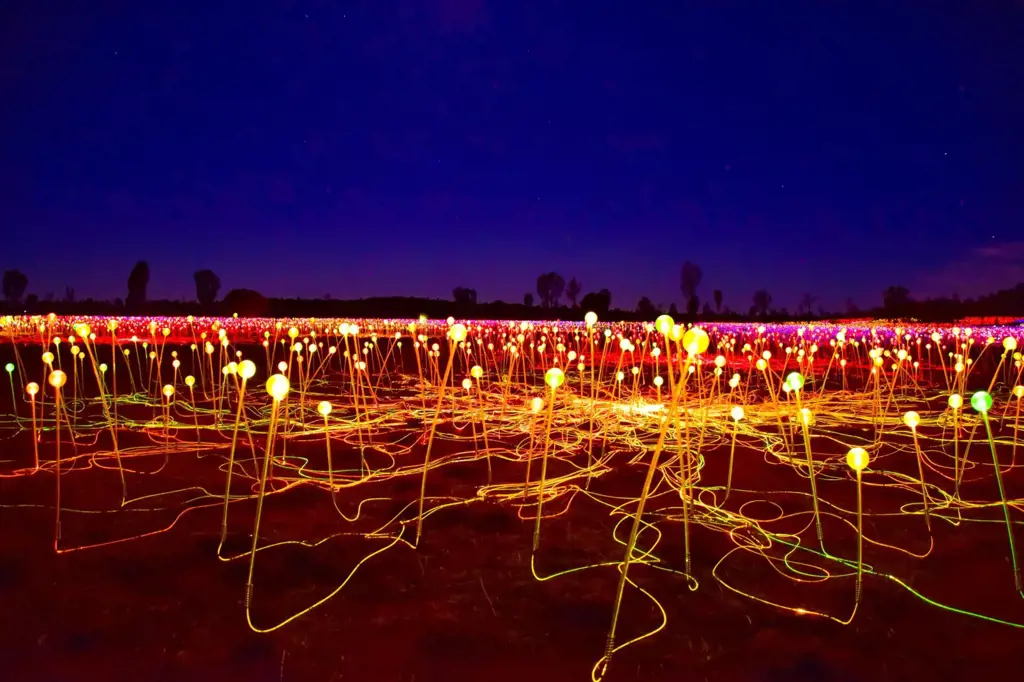
Uluru, also known as Ayers Rock, is an iconic and sacred site in the heart of Australia's Northern Territory. Known for its stunning red rock formations and cultural significance to the Indigenous Anangu people, Uluru is a must-visit destination for any traveler to Australia. However, one of the most unique and memorable experiences that visitors can have at Uluru is visiting the Field of Light at night.
The Field of Light is an art installation by British artist Bruce Munro, consisting of thousands of colorful lights spread out across an area the size of seven football fields. The lights are arranged in a pattern that resembles the wildflowers that bloom after a desert rain, creating a mesmerizing and enchanting spectacle that is truly unforgettable. The installation is open from dusk until midnight, allowing visitors to experience the artwork in different lighting conditions.
Visiting the Field of Light at night is a truly magical experience. As visitors wander among the glowing lights, they are transported to another world, where the stars above and the lights below blend together in a kaleidoscope of color and movement. The quiet beauty of the desert is enhanced by the gentle hum of the art installation, creating a sense of peace and tranquility that is hard to find anywhere else.
The Field of Light is located a short distance from Uluru, and can be accessed via a shuttle bus service from the Ayers Rock Resort. Visitors can choose to explore the installation on foot, or take a guided tour that provides in-depth information about the artwork and its significance to the culture and history of the area.
Overall, visiting the Field of Light at night is an absolute must-do when visiting Uluru. The installation is a breathtaking and unforgettable experience that showcases the beauty and wonder of the Australian outback, while also paying tribute to the rich cultural heritage of the local Indigenous peoples. Whether you're a seasoned traveler or a first-time visitor to Australia, the Field of Light is an experience that you will treasure for a lifetime.
14 Fun Things to Do in Coupeville
You may want to see also

Discover the Kings Canyon

Uluru is unarguably one of Australia's most iconic landmarks and a popular tourist destination that attracts millions of visitors from across the world. However, while many tourists flock to take selfies with the imposing rock formation, not many venture out to discover the equally breathtaking Kings Canyon.
Located in the Watarrka National Park, South Australia, Kings Canyon boasts of beautiful landscapes and exciting activities that make it a must-visit destination for any traveler. The Canyon is situated about 450km from Uluru and is a perfect getaway for visitors who would like to experience more of Australia's natural beauty.
The Kings Canyon walk is one of the main attractions, and it features a breathtaking 6km hike along the rim of the Canyon, which provides awe-inspiring views of the landscape below. The walk is best done at sunrise or sunset when the colors of the surrounding rock formations are at their most vibrant. During the walk, you will witness the Garden of Eden, a stunning and unique oasis that is home to a wide variety of plant and animal life.
If you are up for an adrenaline-filled adventure, then the Rim Walk is a must-try. This 3-4 hour walk takes hikers along the canyon ridge and includes sections of steep ascents and descents while providing awe-inspiring views of the surrounding landscape. Visitors are also treated to amazing views of the surrounding landscape from the highest point, Cotterill's Lookout.
Aside from the Canyon's natural beauty, visitors can immerse themselves in the area's local cultural and historical significance. The local Anangu people have inhabited this area for thousands of years, and there is an opportunity for visitors to engage in learning about their culture and history.
In conclusion, while Uluru is a must-visit destination for anyone visiting Australia, it's essential not to overlook Kings Canyon. This region offers visitors an exciting escape into Australia's beautiful natural landscapes and offers an opportunity to immerse oneself in the local culture, making it a perfect destination to add to your Australian itinerary.
12 Unique Ideas for a New Orleans Bachelor Party
You may want to see also

Learn about the Western Arrernte culture

Uluru, also known as Ayers Rock, is one of Australia’s most iconic landmarks and a sacred place for the Aboriginal people of Australia. The Western Arrernte people are one of the many Aboriginal groups that call Uluru their spiritual home. In this article, we’ll explore some of the key aspects of Western Arrernte culture and learn about their connection to Uluru.
The Western Arrernte people are the traditional owners of the land in and around Alice Springs, which is located roughly 450 km to the north of Uluru. Despite this distance, the Western Arrernte have a deep spiritual connection to Uluru and consider it to be a place of great cultural significance.
For many generations, the Western Arrernte have used Uluru as a place for ceremony, storytelling, and cultural exchange. Elders pass on knowledge and wisdom to younger generations through song, dance, and storytelling, all of which are deeply connected to the land and its natural features.
One example of this is the Tjukurpa Dreaming, which is the Western Arrernte’s creation story. According to this Dreaming, Uluru was formed by the actions of the Ancestors, who shaped the landscape and established the laws and customs that govern Western Arrernte society today.
The Western Arrernte also have a strong respect for the land and the natural world around them, and they believe that everything in nature is connected. This can be seen in their traditional land management practices, which involve carefully balancing the use of resources with the protection of sacred sites and important habitats.
In recent years, the Western Arrernte people have taken a more active role in managing and protecting Uluru. In 1985, the land surrounding Uluru was handed back to the traditional owners, and they now work in partnership with the Australian government to manage the area together.
Nowadays, visitors to Uluru have the opportunity to learn about Western Arrernte culture through guided tours and cultural experiences. This is an important way for non-Indigenous people to gain a greater appreciation of Aboriginal culture and to deepen their understanding of the land and its spiritual significance.
In conclusion, the Western Arrernte people have a rich and ancient cultural heritage that is deeply rooted in the land around Uluru. By learning about their culture and traditions, visitors can gain a greater appreciation of the spiritual significance of Uluru and the Aboriginal people who have called this place home for generations.
12 Must-Do Activities in Phoenix in August
You may want to see also

Hike in the Valley of the Winds

| Characteristic | Description |
|---|---|
| Name | Kata Tjuta - Valley of the Winds |
| Type | Hiking area in Petermann, Australia |
| Website | Go to website |
| Rating / Review count | 4.8 / 551 |
| Address | Kata Tjuta Rd, Petermann NT 0872, Australia |
| Phone | +61 8 8956 1128 |
Uluru, also known as Ayers Rock, is one of Australia's most iconic landmarks. It's a massive sandstone rock formation that rises 348 meters above the surrounding desert in Northern Territory. Uluru is a site of great cultural significance for the Indigenous Anangu people, who have lived in the area for over 30,000 years. Visitors come from all over the world to experience the majesty of Uluru, and one of the best ways to do that is by taking a hike in the Valley of the Winds.
The Valley of the Winds is a trail that takes you deep into the heart of Uluru. It's a four-hour round trip that covers approximately 7.4 kilometers of varied terrain. The trail begins at the Kata Tjuta Dune Viewing Area, and it's marked with signs and trail markers to guide you along the way.
The hike itself is a challenging but rewarding experience. The trail takes you through a rugged landscape of rocky outcrops, gorges, and valleys. The terrain can be steep and rocky, so it's critical to wear sturdy hiking shoes and bring plenty of water. But the views are worth the effort – the Valley of the Winds offers some of the most incredible vistas of Uluru.
As you hike deeper into the Valley, you'll encounter two prominent lookout areas – the Karu Lookout and the Karingana Lookout. These lookouts offer sweeping views of Uluru and the surrounding desert, and they're an excellent place to take a break and refuel.
In addition to the stunning scenery, the Valley of the Winds is also home to unique flora and fauna. You might spot some red kangaroos, wallabies, and echidnas along the trail. The plants in the area are also adapted to the harsh desert environment, including spinifex, desert oak, and various species of acacia.
Throughout the hike, you'll also learn about the cultural significance of Uluru and its surrounding landmarks. The Anangu people believe that the natural features of the land reflect their creation stories and cosmology. The guided tours offered at Uluru can provide you with more information on the cultural significance of the area.
In conclusion, hiking in the Valley of the Winds is a must-do for anyone visiting Uluru. It's an opportunity to experience the raw beauty of the desert landscape and connect with the cultural significance of this sacred site. It's a challenging but rewarding hike that will leave you with lasting memories and a deeper appreciation for this unique corner of Australia.
13 Exciting Things to Do in Sugar Land, TX
You may want to see also

Visit the Olgas
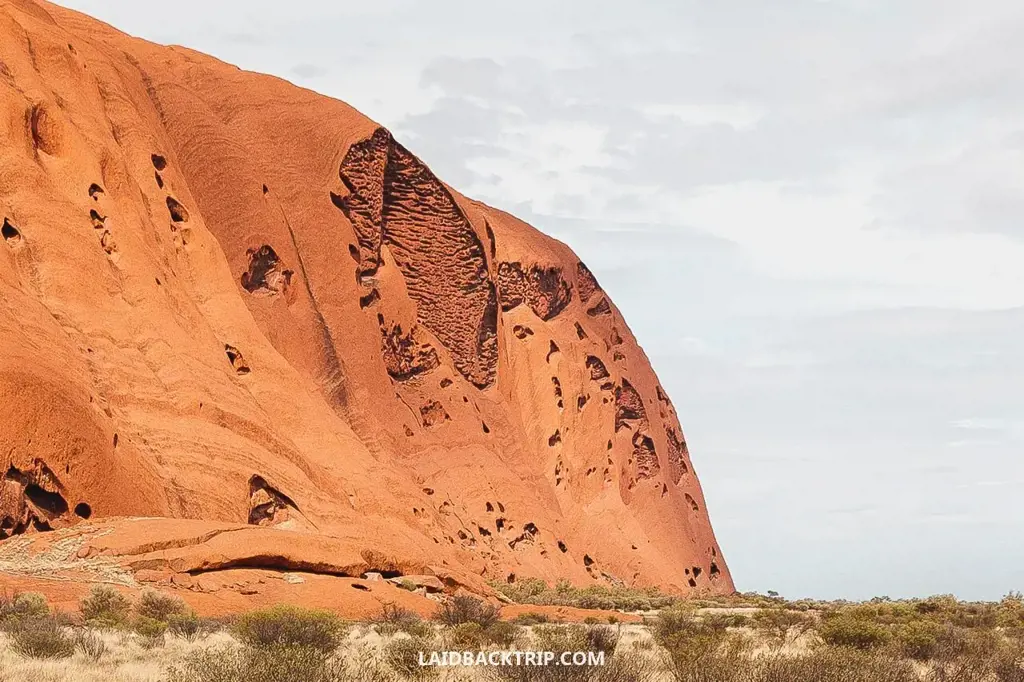
The Olgas, also known as Kata Tjuta, is a must-visit destination when exploring Uluru. Kata Tjuta is located just 25km away from Uluru and is an impressive rock formation comprised of 36 domes that range up to 546m above the desert floor. It's a sacred site for the Anangu people and its name means “many heads” in their language.
Kata Tjuta is a natural wonder that offers an unforgettable experience. Visitors can get a 360-degree view of the vast red landscape by hiking the famous Valley of the Winds track. It’s a moderate to challenging hike, stretching for about 7.4km with two main lookouts offering stunning views of the domes. It takes around 3-4 hours to complete the walk and is best done early in the morning to avoid the midday heat.
For those preferring an easier trek, the Walpa Gorge walk is a great option. It's shorter than the Valley of the Winds hike, about 2.6km return, and takes around 1 hour to complete. It offers a glimpse of the unique flora and fauna of the area and is an excellent option for families and beginners.
Apart from hiking, there are many other ways to experience the beauty and spirituality of the Olgas. Visitors can take a scenic helicopter ride or hot air balloon ride over Kata Tjuta, watch the sunset from a viewing platform while enjoying traditional Australian foods, join a guided tour to learn about the Anangu culture and stories, or simply sit back and admire the wonders of nature.
When visiting the Olgas, it's important to respect and follow the cultural protocol set by the Anangu people. Always stay on designated tracks and respect any sacred sites. Visitors may need to purchase a park pass, and facilities such as campgrounds and visitor centers are available for those planning to stay overnight.
In conclusion, the Olgas is a fascinating destination that's worth visiting during any trip to Uluru. From hiking to cultural tours, there's something for everyone to enjoy and learn about the unique culture and environment of one of the world's most magnificent natural wonders.
12 Fun Activities to Experience in Magnolia Springs, Alabama
You may want to see also

Star gazing in the Outback

If you're looking for a truly unique stargazing experience, the Outback of Australia is the place to be. Specifically, the area surrounding Uluru, a massive sandstone rock formation located in the heart of the continent.
With very little light pollution and clear skies, the stars above Uluru are truly breathtaking. While there are certainly plenty of starry spots to choose from in the Outback, Uluru's towering presence adds an extra special touch to the experience.
If you're not an experienced stargazer, a guided tour is a great way to get started. Several companies offer nighttime tours of Uluru that include telescopes for optimal viewing, as well as knowledgeable guides who can help you spot constellations and other celestial wonders.
One of the most spectacular sights to see when stargazing at Uluru is the Milky Way. The ribbon of stars is particularly visible in this part of the world due to the lack of light pollution. With the naked eye, you can easily spot many of the individual stars that make up this beautiful band.
Another phenomenon to look for is the Southern Cross. This iconic constellation is only visible from the southern hemisphere and is an important part of indigenous Australian culture. According to Aboriginal legend, the Southern Cross represents a stingray that was caught by a fisherman and placed in the sky as a celestial reminder of his success.
While Uluru is undoubtedly a magical place during the day, it's worth sticking around to see it at night too. In addition to the amazing stargazing opportunities, the peace and quiet of the Outback create a serene atmosphere that's perfect for reflection and relaxation.
Whether you're a seasoned astronomer or just someone who enjoys looking up at the night sky, stargazing at Uluru is a truly unique and memorable experience. Don't forget to bring a jacket and some snacks, and prepare to be dazzled by the beauty of the cosmos.
14 Fun Christmas Things to Do in Jacksonville, FL
You may want to see also
Frequently asked questions
There are plenty of exciting things to do in Uluru that cater to different preferences. These include the Uluru base walk, camel riding tours, cultural walks, helicopter rides, and star gazing tours. You can also enjoy cultural performances, experience sunrise and sunset at the Uluru lookout, hike the Kata Tjuta, and attend free ranger-guided activities.
Climbing Uluru is no longer allowed due to cultural and safety concerns. Uluru is considered a sacred site by the local Aboriginal community, and climbing the rock is seen as disrespectful to their cultural beliefs. Moreover, climbing the steep and rocky terrain poses significant dangers to tourists, causing many injuries and deaths over the years.
The ideal time to spend in Uluru depends on your itinerary and preferences. However, most tourists spend between 2-4 days to fully experience the natural beauty and cultural richness of the area. This timeframe allows you to explore the various attractions, take part in activities and tours, and relax amidst the serene surroundings.
Uluru can be visited all year round, but the best time to visit depends on your preferences and what you would like to experience. The summer months (December-February) have hot temperatures during the day and cooler nights, while the winter months (June-August) offer milder daytime temperatures and cold nights. However, the shoulder months of March, April, September, and October offer comfortable temperatures, fewer crowds, and vibrant scenery.








3 Comments
Randy Hodge
Karisa Garcia
AuthorMohammad Dale